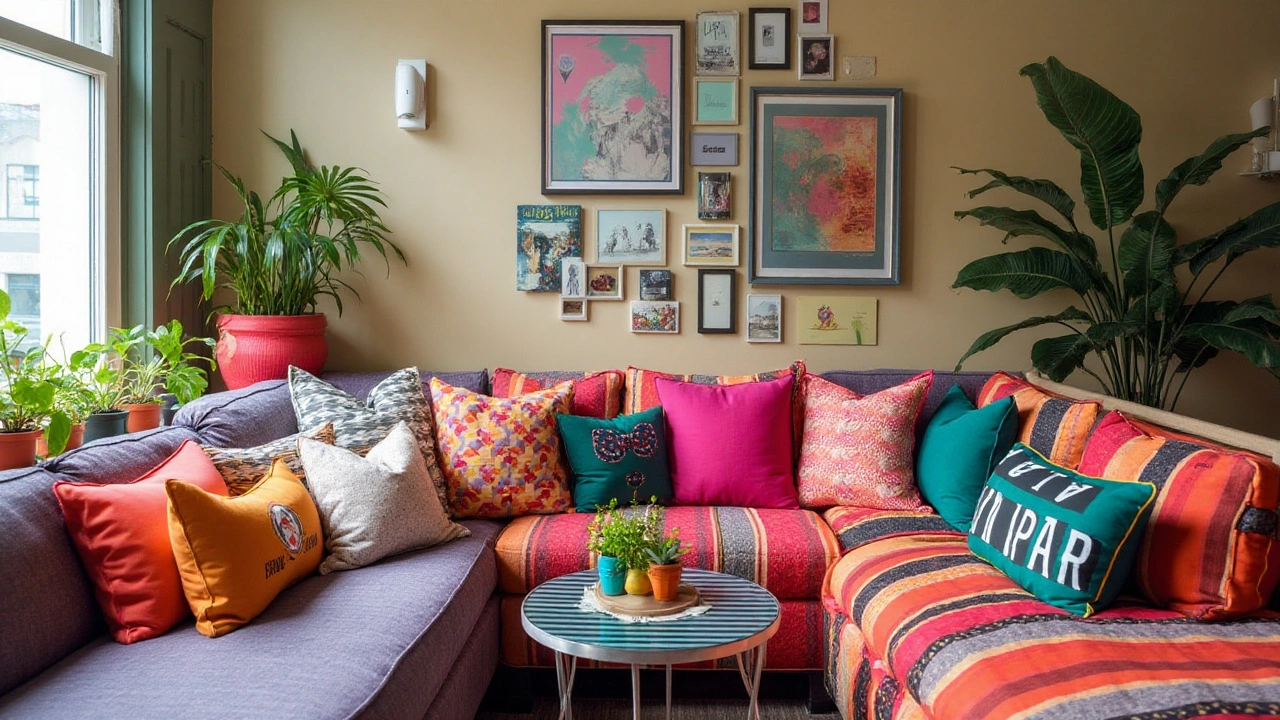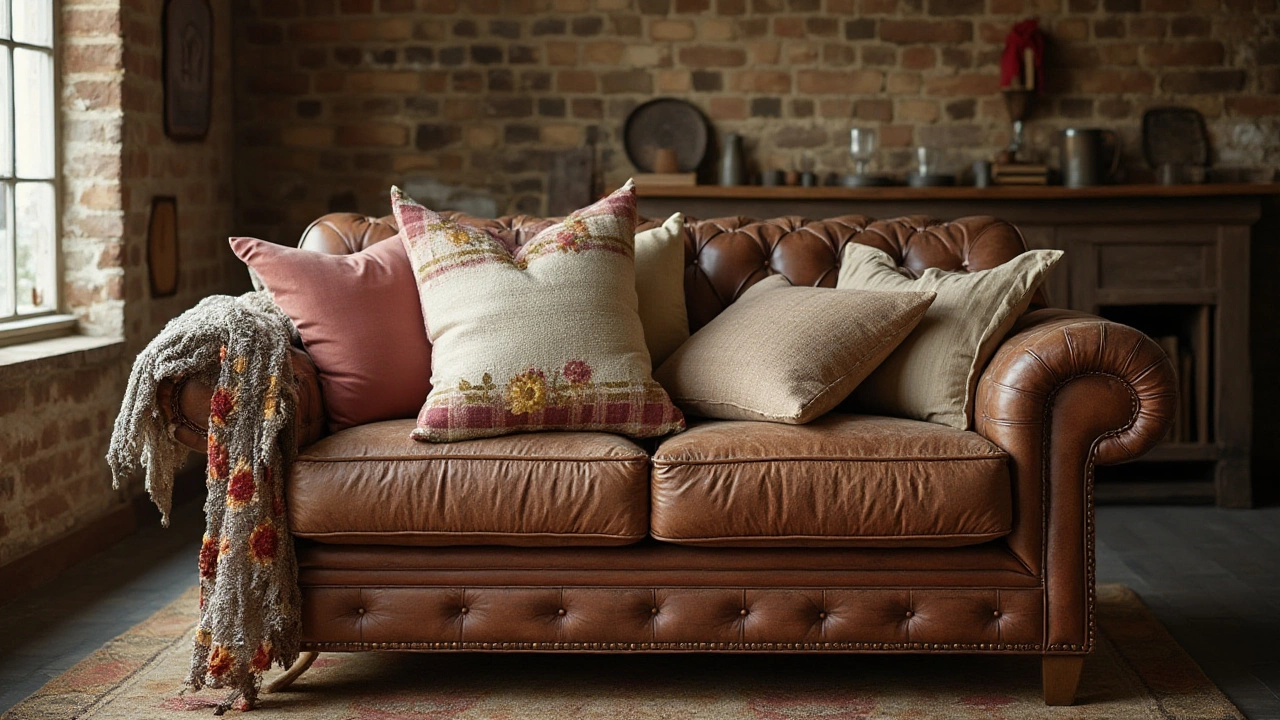Choosing the Perfect Cushions for Your Sofa
 Aug, 21 2024
Aug, 21 2024
Making your couch comfy and stylish doesn't have to be a mystery. Choosing the right cushions can bring your living room to life, adding not just comfort but also a touch of personality. The variety is vast, from small decorative pillows to large, plush ones that you can sink into. Each type serves a different purpose and meets different tastes.
Understanding the materials can help you pick cushions that feel good and last. Whether you prefer fluffy feathers or firm foam, the filling plays a role in the cushion's comfort and durability. Beyond that, the cover's texture can set the tone: smooth silks for elegance or rugged cottons for a more casual vibe.
Then, there's the visual aspect. Colors and patterns have the power to transform a room. Bold patterns make a striking statement, while soft, neutral colors can create a calming backdrop. Lastly, how you arrange your cushions can change the mood of your space, making it more inviting or organized.
Types of Couch Cushions
Exploring different types of couch cushions is like taking a journey through comfort and style, where each choice brings its own unique touch to your living space. When it comes to settling in after a long day, the decisions you make about your cushions can be as important as picking the couch itself. From decorative throws to supportive seat pads, each type serves a purpose and fits into your home’s story.
Decorative Cushions
These are the charmers of the cushioning world. Typically smaller in size, they are designed more for visual appeal than for functional support. A common size is 18x18 inches, but they can vary widely depending on the intended effect. Decorative cushions are perfect for adding splashes of color and textures, livening up neutral-toned sofas with patterns that range from traditional prints to modern abstract designs. According to a 2021 interior design study, using cushions with vibrant prints nearly doubles perceived sofa appeal among test subjects.Throw Pillows
Another popular option in the cushion universe is the throw pillow. Often found in pairs on either end of a sofa, these cushions combine aesthetics and a bit of neck or back comfort. Materials frequently used are cotton, velvet, or linen, and their size is typically around 20x20 inches. Try matching these cushions to an accent color in your room for a cohesive design approach. However, they can also stand independently to make a bold statement. A famous designer once remarked, "Throw pillows are the jewelry of furniture, adding just enough glint and glimmer to catch the eye," encapsulating their importance in home decor.Lumbar Support Cushions
Functionality takes center stage with lumbar cushions. Designed to provide adequate support for the lower back, these are perfect for anyone looking to add ergonomic benefits to their home comfort. Usually rectangular and thinner than other cushions, they fit perfectly along the spine. Covering these in breathable fabrics helps maintain a pleasant temperature, making them a great choice for longer periods of sitting. Reports suggest that proper back support can reduce discomfort in the lower back by 30% during prolonged sitting.Floor and Seating Cushions
These adaptable cushions are perfect for those who love versatility in their spaces. They're larger, ranging from 24 to 36 inches, and they work both as extra seating and as a laid-back lounging option. Made from thicker materials like faux fur or durable cotton blends, they often come in bold patterns and rich colors. These are ideal for families or those who frequently entertain, offering casual seating in an unstructured space. Add a few of these to create a bohemian feel or mix in neutrals for a modern minimalist approach.Choosing the right type of cushion transforms more than just furniture; it changes the essence of a room, imbuing it with personality, comfort, and style. Whether you are a minimalist or love maximalist aesthetics, there's a cushion out there that matches your vibe perfectly.

Material Matters
When it comes to picking the perfect couch cushions, the choice of material plays a crucial role. It's not just about the visual appeal; the material defines the cushion's texture, how it feels against the skin, and most importantly, its durability. Each type of material brings its unique charm and drawbacks. Let's discuss some popular options that many homeowners consider today.
Firstly, cotton continues to be a favorite for its breathability and ease of maintenance. It's a natural fiber, making it a sustainable choice for many eco-conscious individuals. Cotton cushions are quite versatile, available in a plethora of colors and patterns, allowing them to blend into any sofa decor. The softness of cotton makes it particularly suitable for homes with kids or pets, as it provides added coziness. However, cotton can fade over time when exposed to direct sunlight, so considering your room's lighting is vital.
Synthetic materials like polyester or microfiber are also prevalent for their durability and resistance to wear and tear. These materials can easily repel stains, an essential feature for cushions used in high-traffic areas. Polyester can mimic natural textures, offering a range of appearances from sleek to plush. Yet, it's worth noting that while synthetic materials are durable, they may not provide the same level of comfort as natural fibers, sometimes feeling less breathable and thus not ideal for warmer climates.
"The sustainability of different cushion materials has gained increasing attention. By choosing responsibly sourced fibers, you help reduce environmental impact dramatically," says Jane Parker, a renowned eco-design expert.
Then there's the luxury of velvet and silk cushions that add a touch of elegance and sophistication to any living room. Velvet offers a rich texture and a vibrant look, catching the light beautifully, though it can be slightly more challenging to maintain due to its sensitivity to spills and stains. On the other hand, silk exudes luxury and feels incredibly soft against the skin, but it comes with a higher price tag and demands delicate care.
A hybrid approach often sees cushions with mixed materials, where the exterior is crafted from natural fibers, and the interior consists of synthetic supports. This blend often encapsulates the best of both worlds, offering the comfort of a natural outer layer with the resilience of a synthetic core. Such combinations can provide added support, which is particularly beneficial for larger cushions where maintaining shape is crucial.

Color and Pattern Selection
Selecting the right color and pattern for your couch cushions can make all the difference when it comes to the vibe and character of your living space. Colors evoke emotions, and each hue can bring a different feeling to your room. For instance, blues and greens often generate a sense of calm, echoing natural landscapes, while reds and oranges can inject energy and warmth, making your living room a lively gathering spot. If your room is already buzzing with loud colors, choosing neutral cushions might maintain balance, creating a harmonious backdrop without overwhelming the senses.
Patterns can be equally powerful, with the potential to turn the mundane into the extraordinary. Stripes can offer a classic appeal, introducing a structured vibrancy that keeps things interesting without causing any disturbance. Meanwhile, floral patterns can bring a natural element indoors, pairing beautifully with rustic or vintage decor. Geometric or abstract patterns are especially on-trend, satisfying those who seek modernity and edge. According to The Psychology of Patterns, understanding how people respond to different patterns can help in creating a space that not only looks nice but also feels good.
"Color is a power which directly influences the soul." - Wassily Kandinsky
When dealing with both colors and patterns, the golden rule is to keep it cohesive with the existing decor of your room. Have a look at your existing furniture, curtains, and flooring, and try to find a common theme or color scheme. A useful method is the 60-30-10 rule, a timeless interior design trick. It suggests that 60% of the room should be a dominant color, 30% a secondary color, or texture, and the last 10% an accent. Cushions usually fall into that 10%, giving you creative freedom without overstepping the boundaries.
To help visualize the effect of different combinations, consider using a mood board. This involves collecting fabric swatches, images, and paint cards, allowing you to see all your ideas together. Even at the physical store, carrying samples could help you get an idea of how cushions with certain colors might look on your couch. Experimenting is key, as it often leads to unexpectedly harmonious results. Plus, changing cushion covers with the seasons is a simple, budget-friendly way to refresh the room's look. So, get playful with your sofa decor, and don't be afraid to mix and match until it feels just right.

Cushion Arrangement Tips
Arranging couch cushions might seem like a trivial task, but it has the power to change the vibe of your living space dramatically. The way you arrange these soft pieces of decor can either make your couch look inviting and well-thought-out or, conversely, chaotic and disorganized. First, consider the size and shape of your cushions. Larger cushions work well at the back, providing a base, while smaller ones can be used at the front. This not only creates a sense of depth but also makes it easy to add layers of style.
Mix and match cushion styles to bring out the best in your room. Uniformity is comforting, but a little asymmetry adds charm and interest. Opt for odd numbers when arranging cushions; this often works better than even numbers. For instance, a setup with five cushions might include two large ones, two medium, and a smaller, eye-catching option that ties the arrangements together. Positioning them at varying angles can also break monotony, allowing them to cradle into one another. "Don’t be afraid to play with an asymmetrical setup," says interior designer Emily Henderson, who swears by the dynamic visual interest it adds.
Colors and patterns are equally crucial in cushion placement. A good trick is to use a trio of colors: a dominant, a secondary, and an accent color. Use the dominant shade on the largest cushions which form the base layer. The secondary color can contrast or complement, often found in the cushions at the middle, while the accent color is ideal for the smallest cushions that pop. Striking the right balance can either highlight your sofa decor or drown it in too many hues, so choose wisely.
Another aspect is texture, which can add significant interest and depth to your arrangement. Different materials like velvet, linen, or cotton, each offer unique textures that can create a tactile experience in your living room. You might want to mix smooth and rough textures to create a balanced yet inviting setup. It’s like creating a sensory invitation for anyone who comes to visit. Offering an arrangement that’s not just visually appealing but also lovely to touch is key to enhancing your home comfort.
Finally, the arrangement should ultimately reflect your personal taste. Your living room should feel like a place where you can relax, and the cushions are a crucial part of that. Trust your instincts as they can often lead you to the best layout for your space. Whether you prefer a minimalist approach with fewer cushions or an eclectic mix with plenty of cushions of different colors and sizes, make sure it resonates with your style and feels right for your home.